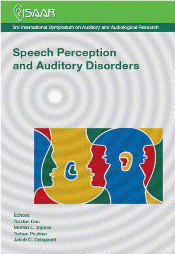Re-focussing on the clinical targets
Abstract
The objective of this presentation is to re-examine the clinical targets for hearing aid recommendation and processing. The main clinical target is the damaged cochlea, and the main measure discussed will be the many patterns of clinical word recognition across level. Study of human temporal bones allows appreciation of the underlying damage to the cochlea in hearing aid cases, with somewhat surprising implications. Primarily, it is necessary to allow for and respond to, a model of depletion of the sensory epithelium (as in macular degeneration). There is an important difference between reverse- engineering the audiology results and providing maximum information to a depleted receptor array. Diagnosis using word recognition, recommendation criteria, and implications for delivering optimal hearing aid output and for studying the results will be discussed.
References
Carhart, R. (1946). “Individual differences in hearing for speech” Ann. Otol. Rhinol. Laryng. 55, 233-266.
Halpin, C., Thornton, A., and Hasso, M. (1994). “Low-frequency sensorineural hearing loss: Clinical evaluation and implications for hearing aid fitting” Ear Hear. 15 (1), 71-81.
Halpin, C. (2002). “The tuning curve in clinical audiology” Am. J. Aud. 11, 56-64. Halpin, C., and Rauch, S. (2009a). “Clinical implications of a damaged cochlea: pure tone thresholds versus information carrying capacity” Otolaryng. – HNS 140 (4), 473-476.
Halpin, C., and Rauch, S. (2009b). “Hearing aids and cochlear damage: The case against fitting the pure tone audiogram” Otolaryng. - HNS 140 (5), 629-632.
Kiessling, J. (2001). “Hearing aid fitting procedures: state of the art and current issues” Scand. Aud. 52 (Suppl), 57-59.
Kochkin, S. (2011). “MarkeTrak VIII: Patients report improved quality of life with hearing aid usage” Hear. J. 64 (6), 25-32.
Kochkin, S. (2005). “MarkeTrak VII: Consumer satisfaction with hearing instruments in the digital age” Hear. J. 58 (9), 30-43.
Merchant, S., and Nadol, J. (Eds) (2010). Schuknecht’s Pathology of the Ear, 3rd Edition. PMPH-USA. Shelton CT.
Mulrow, C., Aguilar, C. and Endicott, J. (1990). “Quality-of-life changes and hearing impairment: a randomized trial” Ann. Intern. Med. 113, 188-194.
Plomp, R. (1988). “The negative effect of amplitude compression in multichannel hearing aids in the light of the modulation transfer function” J. Acoust. Soc. Am. 83 (6), 2322-7.
Preminger, J. (2007). “Issues associated with the measurement of psychosocial benefits of group audiologic rehabilitation programs” Trends Amplif. 11 (2), 113-123.
Souza, P., Boike, K., Witherell, K., and Tremblay, K. (2007). “Prediction of speech recognition from audibility in older listeners with hearing loss: effects of age, amplification and background noise” J. Am. Acc. Aud. 18 (1), 54-65.
Stillman, J., Zwislocki, J., Zhang, M. and Cefaratti, K. (1993). “Intensity just- noticeable differences at equal loudness levels in normal and pathological ears” J. Acoust. Soc. Am. 93 (1), 425-34.
Thornton, A., and Raffin, M. (1978). “Speech discrimination scores modeled as a binomial variable” J. Sp. Hrng. Res. 21, 507-518.
Vinay and Moore, B. (2010). “Psychophysical tuning curves and recognition of high pass and low pass filtered speech for a person with an inverted V-shaped audiogram (L)” J. Acoust. Soc. Am. 127 (2), 660-663.
United States Department of Health and Human Services (2003). ICD-9-CM. Author.
Additional Files
Published
How to Cite
Issue
Section
License
Authors who publish with this journal agree to the following terms:
a. Authors retain copyright* and grant the journal right of first publication with the work simultaneously licensed under a Creative Commons Attribution License that allows others to share the work with an acknowledgement of the work's authorship and initial publication in this journal.
b. Authors are able to enter into separate, additional contractual arrangements for the non-exclusive distribution of the journal's published version of the work (e.g., post it to an institutional repository or publish it in a book), with an acknowledgement of its initial publication in this journal.
c. Authors are permitted and encouraged to post their work online (e.g., in institutional repositories or on their website) prior to and during the submission process, as it can lead to productive exchanges, as well as earlier and greater citation of published work (See The Effect of Open Access).
*From the 2017 issue onward. The Danavox Jubilee Foundation owns the copyright of all articles published in the 1969-2015 issues. However, authors are still allowed to share the work with an acknowledgement of the work's authorship and initial publication in this journal.


